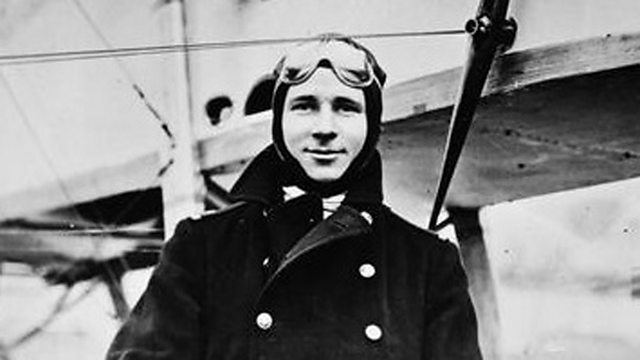Highworth, Wiltshire: The First Man to Destroy a Zeppelin
A war hero who was the first to shoot down a feared German aircraft
If you’re called to see the headmaster at Warneford School in Highworth, Wiltshire, you’ll be kept company as you wait by a black and white picture of a naval aviator.
The picture is of Flight Sub Lieutenant Rex Alexander John Warneford. Known as Rex, who was born in India in 1891 but was educated in England. When war broke out, Rex joined the army but transferred to the Royal Naval Air Service for pilot training.
To commemorate Warneford’s feat, one of his modern day counterparts went to the school, which bears his family name.
Lt Commander Chris Gotke is the Commanding Officer of the Royal Navy Historic Flight, based at Yeovilton. He went to Warneford School in Highworth to give students a better understanding of how Rex Warneford came to earn his Victoria Cross.
Warneford’s aggressive piloting style came to the fore on 7 June 1915. Flying near Ghent, in Belgium, he spotted a German airship, commonly called Zeppelins. Bringing his Marne-Saulnier Type L aeroplane close enough to attack, he chased the airship, LZ-37, until he was successful in dropping bombs on it.Having been driven off by the Zeppelin’s defensive fire, Warneford decided to withdraw and make a stealth approach by means of turning off his engine.
The last of his bombs caused an explosion big enough to tumble Warneford’s aircraft.
Warneford’s written report is undramatic. “When close above him (at 7,000ft) I dropped my bombs, and whilst releasing the last, there was an explosion which lifted my machine and turned it over. The aeroplane was out of control for a short period, but went into a nose dive, and the control was regained.”
He glided his plane to a landing behind enemy lines while the airship crashed near Sint-Amandsberg.
For his bravery, Warneford was awarded the Victoria Cross. The citation from the Admiralty is a little more dramatic in its wording, describing a ‘brilliant achievement’, and the air ship being destroyed through a ‘terrific explosion which set the Zeppelin on fire from end to end.” The exuberant wording is understandable.
Up until Warneford’s feat, German airships were seen as indestructible and untouchable foes, to be feared whenever seen or heard.
Warneford was also given the Legion d’honneur by the French. Ironically, it was on the same day that he received the French award, 17 June 1915, that Rex Warneford was to die.
He had gone to the aerodrome at Buc, near Versailles, to pick up a new aircraft to fly to Dunkirk.
After a short test flight, which went well, he flew a second flight, carrying an American journalist. Even eye witnesses were unsure of the actual cause of the catastrophic collapse of a wing which led to the crash. The journalist died instantly, while Warneford died en route to hospital.
Rex Warneford was buried in London on 21 June 1915. The ceremony was akin to a state funeral with an estimated 50,000 mourners paying their respects.
The Warneford family had a home at Sevenhampton, near Highworth, and so when the local secondary school needed naming in the 1950s, the family connection was commemorated then.
Students at the school decided to run an experiment to show to Lt Commander Gotke. They wanted to find out how difficult it would have been for Rex Warneford to do what he did.
“What we’ve got is one pupil riding backwards and forwards on a bicycle with a bucket on her back. That makes her the Zeppelin”, says Headteacher, John Saunders. “Then we’ve got other pupils in an upstairs classroom, dropping water bombs on her. At the same time, we’ve got pupils at ground level throwing tennis balls at the students above to simulate the distraction of the return fire coming fire coming from the Zeppelin.”
Ahead of the experiment everyone thought it would be easy. The 14 water bombs quickly disappeared as the difficulty of the task became apparent. It took all of them to make that elusive ‘hit’ on the ‘Zeppelin”.
The pupils agreed it was harder than they had imagined and said the experienced heightened their understanding of what Rex Warneford achieved.
Headteacher Chris Gotke summed up the experience for the students: “We’ve just proven that it wasn’t an easy thing to do. From my angle, being a Harrier man, and privileged to fly aircraft of the '40s, '50s and '60s, it’s amazing to think of somebody who can go out and do this. A hell of a story and the story of a great man who proved you can beat the odds.”
Location: Highworth Warneford School, SN6 7BZ
Image shows Flight Sub Lieutenant Rex Alexander John Warneford, courtesy of Imperial War Museums
Presented by Lt Commander Chris Gotke from the Royal Navy Historic Flight at Yeovilton, with the students of Highworth Warneford School
Duration:
This clip is from
Featured in...
![]()
����ý Wiltshire—World War One At Home
Places in Wiltshire that tell a story of World War One
![]()
War in the Air—World War One At Home
Zeppelin raids and aviation heroics
More clips from World War One At Home
-
![]()
The loss of HMY Iolaire
Duration: 18:52
-
![]()
Scotland, Slamannan and the Argylls
Duration: 07:55
-
![]()
Scotland Museum of Edinburgh mourning dress
Duration: 06:17
-
![]()
Scotland Montrose 'GI Brides'
Duration: 06:41







